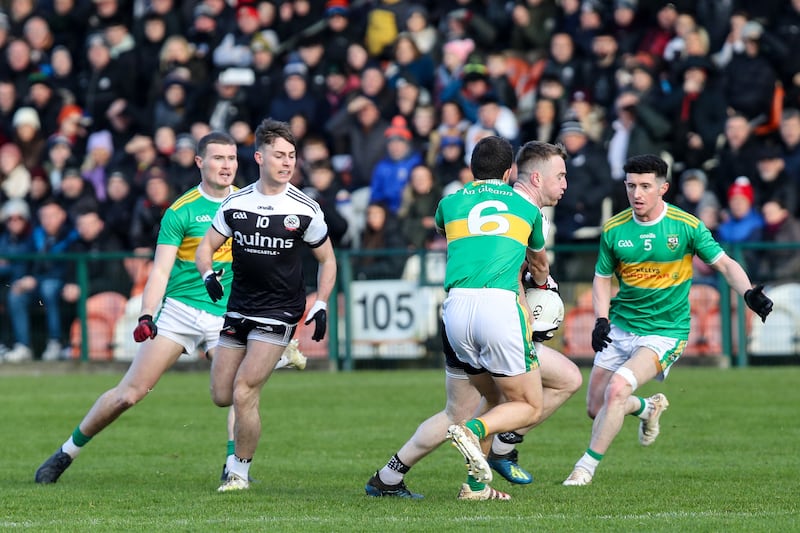A winter World Cup has been a bewitching thing for the last few weeks. November is a long and tedious month for many of us, and it has been rather easier to carve out some time in your day to watch multiple World Cup games over the last couple of weeks than it usually is in summertime, when there are multiple competing factors in one’s life to contend with.
Thinking back to the last iteration in 2018, I remember successfully playing a Gaelic football match, enduring the post-match huddle, skating past a couple of dozen people standing at the dressing-room door, and getting into my car – all without finding out the score in the Argentina-Nigeria game that was happening at that very moment, and which featured the only really joyous Lionel Messi moment of that World Cup. When I saw him smash home the decisive goal in that game, an hour or so after it had actually happened, I was experiencing it as if in real time.
I also remember trying to follow Argentina v France on the beach a few days later, solemn promises that after the requisite amount of lounging, we’d depart to the pub for the game long gone by the wayside. The day was too nice, and I had to make do with watching it on patchy 4G on my phone, with three or four of us gathered around making out what we could.
There was no fear of being caught on the beach for an Argentina game this time round, certainly not on Tuesday night as they hammered Croatia 3-0 in the first of the semi-finals, while temperatures plummeted below zero around Ireland.
Inside Gaelic Games: The weekly GAA newsletter from The Irish Times
Cork’s red mist gave Clare chance to make the numbers count
Seán Moran: Sobering question for the GAA - does intercounty involvement do players more harm than good?
Leinster excel when it comes to refining link between attack and defence
But of course, it doesn’t look like a winter World Cup, not on television. It doesn’t even look like a Middle Eastern World Cup. The action is instead unfolding on Planet Fifa. I read a very interesting piece on the Athletic website by Adam Hurrey, of the Football Clichés podcast, on why every World Cup now looks the same.
There was a time, as Hurrey demonstrates using the example of Brazil playing a team in red shirts from various World Cups in the last century, when each world cup had a distinctive “look” – if you saw a goal from Mexico 86, devoid of any other context, you’d still be able to instantly guess where it came from, just by the camera angle, the lighting, the look of the stadium and the TV graphics.
But in Fifa’s rush to standardise everything about its product, the idea of a World Cup having a particular look or feel is gone. South Africa, Brazil, Russia and Qatar don’t have much in common as countries, but the last four hosts of the World Cup have all had to conform to what Fifa believes a World Cup should look like.
As Hurrey writes: “The immaculate pitches have had one, unerring shade of green since 2014 (dictated in part by Fifa’s ludicrous, 81-page guidance for “pitch illuminance systems”), every game is now broadcast from what feels like a precisely specified Fifa-sanctioned angle.” Every stadium looks the same, and telling one tournament apart from another is now basically impossible.
Sunday, however, was a day off from the World Cup, so we were able to turn our attention to Glen against Kilcoo in the Ulster club final. It may not be GAA-sanctioned, but the aesthetic of Ulster club football in December is nevertheless fairly well-established.

The action was almost unbearably fraught from the opening bell. There was a feeling that all perspective had been entirely lost – that these two tiny communities were in fact engaged in a battle against perspective itself.
It was genuinely enthralling stuff, but it almost left one scratching around for a reason for the intensity of the exchanges. They had only played once before, in last year’s Ulster semi-final, a tight game Kilcoo eventually came out on top in. There was no rivalry there, and yet this had become all-consuming for both squads.
For those of us not directly involved, it can sometimes be difficult to distinguish one Ulster club football game from another, or one titanic Munster club hurling struggle (the struggle is always titanic) from another. There are only two communities with the intensity of feeling required for these games to burn themselves onto the brain.
For the rest of us, what we can recall immediately is the aesthetic. The intercounty man (think of Brendan Maher, or Tony Kelly, or Brian Whelahan in antiquity) providing the moment of class to open the game up, or Peter Canavan or Oisin McConville hitting a free in added time to send the freezing hordes home from Clones or Armagh or Newry happy, with Michéal Ó Domhnaill stoically enduring it all in three layers of raingear on the sideline.
It’s why the recent trend for playing winter club games in Croke Park is perfectly understandable and correct, but nevertheless entirely wrong aesthetically. Ballygunner and Ballyhale should be in Portlaoise this Sunday, with a gale blowing, the pitch only deemed playable an hour beforehand, and a hail shower after 40 minutes to separate the wheat from the chaff.
When the World Cup departs the temporary winter home it finds itself in this year, we will be left with Armagh and Thurles, and the Hyde in a downpour. The exact details of the match might not last long in the memory, but the look of GAA games in winter is eternal.

















